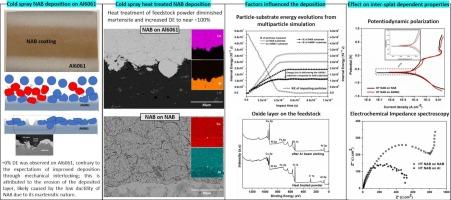镍铝青铜(NAB)在软基板(铝合金)上冷喷涂沉积的见解:强调基板对板间键合的影响
IF 6.9
2区 材料科学
Q2 CHEMISTRY, PHYSICAL
引用次数: 0
摘要
镍铝青铜(NAB)合金因其优异的耐蚀性、抗空化性和适度的磨损性能而广泛应用于船舶和航空航天工业。虽然NAB的冷喷涂已经被广泛研究用于NAB或类似基材的修复应用,但它们在较软的基材上的沉积用于涂层应用仍未被探索。本研究研究了在软铝合金基体上冷喷涂沉积接收和热处理的NAB原料粉末。与预期的机械联锁相反,由于沉积层的侵蚀,观察到沉积效率(DE)可以忽略不计。相比之下,在相同的工艺参数下,热处理粉末的DE接近100% %,这是由于马氏体含量降低。通过硬度和耐蚀性评价板间粘接质量。在NAB衬底上沉积的对比研究进一步阐明了衬底对片间结合和整体涂层性能的影响。采用有限元方法分析了衬底变形对片间边界温度的影响。结果表明,表面氧化层和基底变形消耗的能量显著影响片间边界温度,从而影响片间相关的功能特性。本文章由计算机程序翻译,如有差异,请以英文原文为准。

Insights into cold-spray deposition of Nickel-Aluminum Bronze (NAB) on a soft substrate (Al alloy): emphasizing substrate influence on inter-splat bonding
Nickel-Aluminum Bronze (NAB) alloys are widely used in marine and aerospace industries due to their excellent corrosion resistance, cavitation resistance, and moderate wear properties. While cold spraying of NAB has been extensively studied for repair applications on NAB or similar substrates, their deposition on softer substrates for coating application remains unexplored. This study investigates the cold spray deposition of as-received and heat-treated NAB feedstock powder on a soft aluminum alloy substrate. Contrary to expectations of mechanical interlocking in the as-received powder, negligible deposition efficiency (DE) was observed due to erosion of the deposited layers. In contrast, under identical process parameters, nearly 100 % DE was achieved with heat-treated powder, attributed to the reduced martensite content. Hardness and corrosion resistance were evaluated to assess the inter-splat bonding quality. A comparative study involving deposition on an NAB substrate further elucidated the influence of substrate on inter-splat bonding and overall coating properties. Finite element modeling (FEM) was employed to analyze the impact of substrate deformation on inter-splat boundary temperatures. Results indicate that the surface oxide layer and the energy expended in substrate deformation significantly affect inter-splat boundary temperatures, thereby influencing inter-splat dependent functional properties.
求助全文
通过发布文献求助,成功后即可免费获取论文全文。
去求助
来源期刊

Applied Surface Science
工程技术-材料科学:膜
CiteScore
12.50
自引率
7.50%
发文量
3393
审稿时长
67 days
期刊介绍:
Applied Surface Science covers topics contributing to a better understanding of surfaces, interfaces, nanostructures and their applications. The journal is concerned with scientific research on the atomic and molecular level of material properties determined with specific surface analytical techniques and/or computational methods, as well as the processing of such structures.
 求助内容:
求助内容: 应助结果提醒方式:
应助结果提醒方式:


